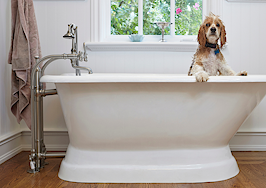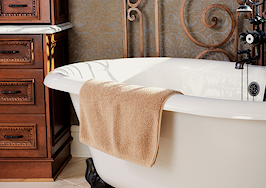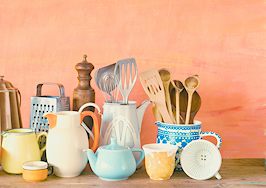Whether it’s refining your business model, mastering new technologies, or discovering strategies to capitalize on the next market surge, Inman Connect New York will prepare you to take bold steps forward. The Next Chapter is about to begin. Be part of it. Join us and thousands of real estate leaders Jan. 22-24, 2025.
This post was updated Nov. 12, 2024.
A real estate agent’s knowledge and understanding of housing periods and styles, often dictated by materials that were available, as well as style changes and buyer demand, will help both the agent and the buyer or seller to communicate and collaborate in their efforts to be successful.
Houses from the 1940s, the decade known as the “beginning of modern design,” were influenced by the Second World War, which started on September 1, 1939, and ended on September 2, 1945. The following decade, the 1950s, saw the modern age blossom and technology reach unprecedented levels of sophistication.
Houses built in the 1940s were constructed of brick with hardwood floors, many on a cement slab. Interior walls still consisted of lathe and plaster, applied on-site, as drywall and gypsum board had yet to come into common usage. It was during World War II that drywall first came into use, as wartime rationing necessitated this building material. Ones who understand 1940s construction techniques will appreciate the strength and solidity of lathe and plaster interior walls.
Conversely, plaster that has not been maintained, either due to dampness or overheated interiors, will exhibit wear and damage. The interiors of houses from the 1940s may have been modernized or repaired with drywall or gypsum board. Home inspectors will be able to determine how the interior walls have been maintained.
Kitchens in the 1940s
Kitchens of the 1940s had breakfast or dining nooks with square or rectangular tables. Sinks were large, often double, with supporting legs and high backsplashes made of molded cast iron, covered with porcelain, always white.
Faucets were chrome and often protruded from the backsplash. If real estate agents encounter 1940s kitchens with sinks still in use, although chipped or yellowed, they can be reglazed and are highly valued.
Stoves of this period were still coal, or more often gas, although electric stoves started to be popular. Laminate countertops had yet to become available, and while wood and stone were sometimes used, tile was the most common.
Distinctive colors of the 1940s kitchen included dark green, after 1945 when the war ended, as this hue was rationed, and navy and air force blue, yellow and red. Walking into a 1940s kitchen today, with the original tile intact, is quite a find and may be a strong selling point to the right buyer. Enamel breadboxes and painted wood cabinets are other features to be aware of.
Hot water tanks were common in kitchens of this time period, as copper tubing carried water through the stove, where it was heated, then returned to the hot water heater for storage.
Washing machines remained in the kitchen for efficiency, next to plumbing for the kitchen sink. Dryers, either gas or electric, had yet to become commonly available.
Small electric appliances were common in kitchens of the 1940s, including irons, toasters, electric tea kettles, stand mixers, and waffle irons. Blenders, microwave ovens, electric coffee makers, and toaster ovens had yet to appear on the scene.
Refrigerators of this time period had freezers on either the top or the bottom, and two-door refrigerators were available. Front-loading dishwashers, while not common in most homes, replaced the top-loading units that preceded the more modern versions.
Standardized kitchen cabinets or the “fitted kitchen”, meaning seamless built-in storage, while available in Europe, were just starting to come to this country. The “L” shaped kitchen was deemed the most efficient, and the “work triangle,” with a maximum of 26 feet from refrigerator to sink to stove, was first introduced by Lillian Gilbreth.
The idea of counting steps between appliances revolutionized kitchen design and the modern home. Not every 1940s kitchen took advantage of this modern thinking, but it was coming into practice.
Bathrooms of the 1940s
Bathrooms of the 1940s still reflected the deep maroons, reds and burgundies of the Art Deco 1930s. Depending on the location of the house, plumbing was modern and efficient, primitive or non-existent.
Statistics reveal that only 55 percent of American homes had a “complete system” consisting of hot and cold running water, a flush toilet, and a tub or shower. Pedestal sinks were still commonplace, as were console sinks on chrome legs. Tubs recessed in arched alcoves, which allowed for showers and a feeling of glamour.
During World War II, “luxury” colors were rare, and after the war, when color returned, it was more somber, with clay pinks or flesh tones and deep burgundy with gray. Built-in vanities or sinks with storage under were not seen in the 1940s, though bathrooms may feature built-in shelving, chest, or cabinetry. This was the age of craftsmanship, and carpentry and tile installation skills were highly valued.
Luxury bathrooms with jacuzzis or whirlpool tubs, bidets, and steam showers had yet to become commonplace. European baths may have enjoyed heated floors and towel bars, but these features were only for the wealthy or elite. Bidets were not commonly used in American bathrooms at this time.
Understanding housing periods and features of different decades is a great tool for the real estate agent to use in talking with sellers and buyers. A sense of history is extremely helpful in tracing the origins of certain trends and seeing how they have evolved into current styles.
The more information a real estate agent has at their fingertips, the better they will be able to deal with buyers and sellers.
Gerard Splendore is a licensed associate real estate broker with Warburg Realty in New York. Connect with him on LinkedIn.























